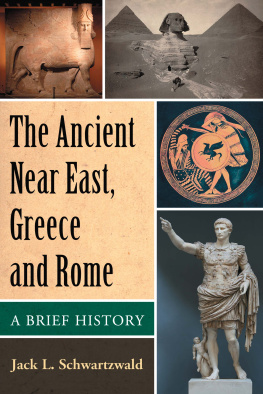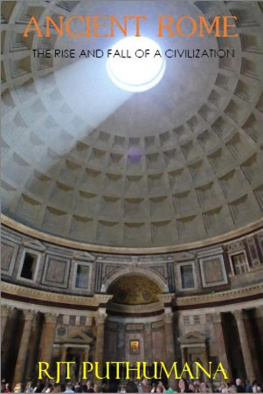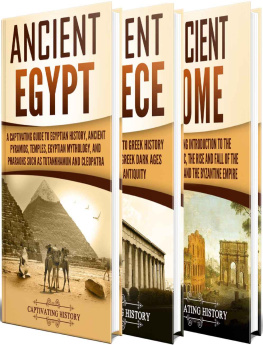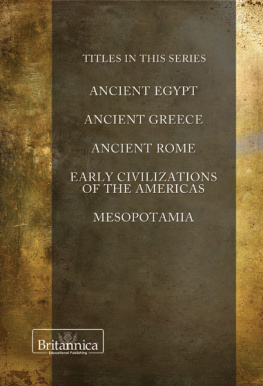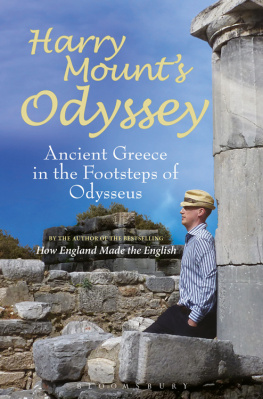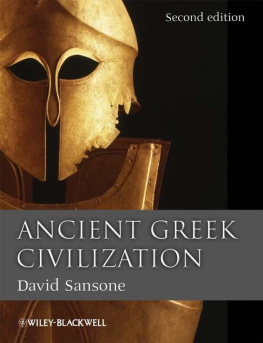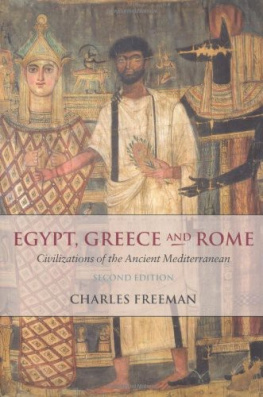
Also by JACK L. SCHWARTZWALD
Nine Lives of Israel: A Nations History Through the Lives of Its Foremost Leaders (2012)
The Ancient Near East, Greece and Rome
A Brief History
JACK L. SCHWARTZWALD

McFarland & Company, Inc., Publishers
Jefferson, North Carolina
LIBRARY OF CONGRESS CATALOGUING DATA ARE AVAILABLE
BRITISH LIBRARY CATALOGUING DATA ARE AVAILABLE
e-ISBN: 978-1-4766-1307-9
2014 Jack L. Schwarzwald. All rights reserved
No part of this book may be reproduced or transmitted in any form or by any means, electronic or mechanical, including photocopying or recording, or by any information storage and retrieval system, without permission in writing from the publisher.
On the cover: (clockwise, from upper left): Neo-Assyrian Lamassu, ca. 721705 BCE; Great Sphinx of Giza, 25582532 BCE; Greek hoplite and Persian warrior on Greek kylix, 5th century BCE; Augustus of Prima Porta, 1st century CE
McFarland & Company, Inc., Publishers
Box 611, Jefferson, North Carolina 28640
www.mcfarlandpub.com
Preface
Asked once what he thought of Western civilization, Mohandas Gandhi replied, I think it would be a good idea. Across the murderous decades of the twentieth century, belief in Western exceptionalism has come to be regarded in some quarters as a form of chauvinism, if not outright bigotry. In 1964, survey courses in Western civilization were a staple of the undergraduate curriculum. A 2010 study, however, showed that none of the United States top fifty universities required such a course. Indeed, only 32 percent even offered onechoosing rather to teach World History. The latter may well seem more appropriate in the current globalized era. But the propagation of Western technology and thought preceded globalization and formed its foundation. Hence, what was true for the West when Edith Hamilton wrote, We think and feel differently [today] because of what a little Greek town did during a century or two, twenty-four hundred years ago is increasingly true in global terms. The legacy of the West has given us our current concepts of individual freedom and responsibilityand the desire to see such concepts understood and disseminated is hardly chauvinistic.
The present volume covers humanitys history from the Stone Age through the fall of the Western Roman Empire in AD 476. It is divided into three parts. Part I encompasses humankinds ascent from barbarism to civilization in the Ancient Near East; Part II witnesses the development of Western civilization in Ancient Greece; and Part III catalogs the failed attempt to build the Wests first nation-state in Ancient Rome. The focus of each part is on political and military history, but all three parts conclude with a segment titled Societal Achievements, which concentrates on the cultural and scientific achievements of the era under study. The foibles of men are abundantly portrayed in these pages but so too is the ascent of mankind.
Through the ages, the approach to recording important events has been governed by two competing axioms. The first, described by the Harvard-trained historian Frederic A. Ogg, maintains that the proper writing of history requires, above all, accuracy and precision, as may be sought in a careful study of primary sources.
Whereas the content of this book has been meticulously researched, an effort has been made to keep the tone informal. With all due respect to the sage advice of Professor Ogg, it has been observed that while Edward Gibbon did not witness the decline and fall of the Roman Empire, he told the story better than anyone else has ever doneincluding the primary sources he relied upon. Hence, while I have adhered strictly to Oggs precepts with regard to accuracy, I have simultaneously done my best not to impede the richness of the subject mattereven if this has meant the insertion of witty quotes from Gibbon where Ogg might have turned to his primary sources. It is hoped that the resulting book will be sought by the beginning college student and the general reader alike, both of whom may be attracted more by a re-spinning of the ripping yarns of history than by the scholastic handling of the material in traditional textbooks.
In creating this volume, much inspiration has been taken from Will and Ariel Durants 11-volume Story of Civilization, H. G. Wells Outline of History, Gibbons Decline and Fall of the Roman Empire and Charles Rollins The Ancient History of the Egyptians, Carthaginians, Assyrians, Babylonians, Medes, Persians, Macedonians and Grecians, all of which similarly sought to combine a comprehensive approach to history with a presentation style that would appeal to a broad audience. A number of textbooks from the heyday of Western civilization survey courses were consulted, chief among them the fifth edition of Brinton, Christopher and Wolffs A History of Civilization (1976), as well as C. Harold Kings A History of Civilization (1964) and Wallbank and Taylors Civilization Past and Present (1954). The extensive historical collections at the libraries of Brown University and the University of Rhode Island provided both primary and secondary source materials, and many thanks are owed to the kind staffs at these institutions for their help in tracking down rare volumes. Inasmuch as Herodotus and the ancient historians who followed him may be taken as primary sources, these were abundantly utilized. J. H. Robinsons Readings in European History, Botsford and Botsfords A Source-Book of Ancient History and Samuel Birchs Records of the Past were also extensively relied upon for primary source materials.
Thanks are owed to many family members and friends for their help and encouragement while this volume was written. My wife Cheryl, as always, showed infinite patience and gave crucial moral support. Without her, this book would not have been possible. Our cats, Cody and Crosby, served as constant research companions and provided punctual reminders on when it was time to take a break. Sincere thanks are also owed to my lifelong friends, Steve Goldschmidt and Tom Fantes, who served as a willing audience for the books early drafts and to my friend and medical colleague, Ben Sapers, who was the first to read the final product. My mother Frankie and sister Ann (both educators), as well as my father Joe, served in their usual capacity as proofreaders-in-chief, catching numerous errors in spelling and grammar. (The responsibility for any remaining errors belongs to me.) Thanks are also extended to my brother David, sister-in-law Rand, nieces Carly and Liza, and nephew Jake (also a writer), who showed much-appreciated interest and enthusiasm for the project.
Notes
See bibliography for full source information.
Preface
Ricketts et al., 1.
Ogg, 6.
Liddell Hart, RW, 423.
Part I
Brinton et al., HCiv, vol. 1, 810.
Roux, 58; Collier, 107.
Larousse, vol. 1, 20; Collier, 81.
Collier, 8082; Fagan, p. 116; Pfeiffer, 6566.
Durant and Durant, vol. 1, 96; Collier, 101; Pfeiffer, 94100.
Brinton et al., HCiv, vol. 1, 9; Fagan, 130; Pfeiffer, 7, 19.
Brinton et al., HCiv, vol. 1, 910.
Collier, 1045, 1078; Fagan, 135.
Collier, 10914.
Brinton et al., HCiv, vol. 1, 10.
Next page
